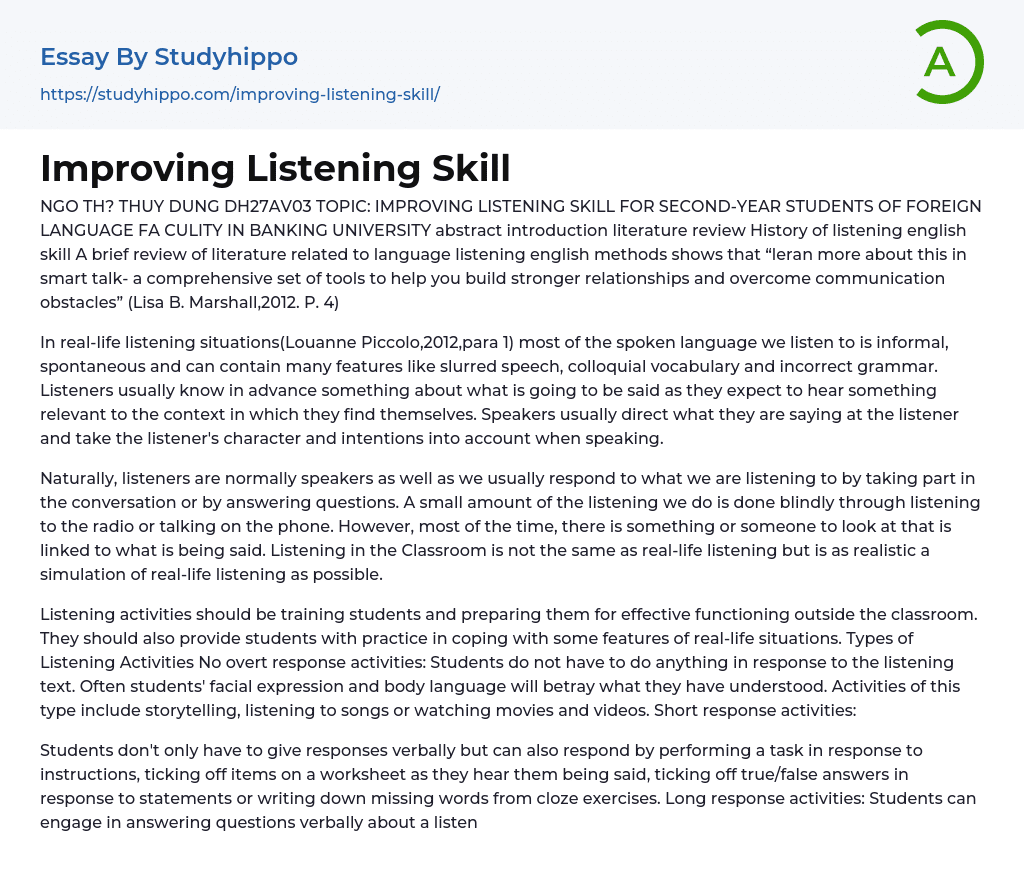

Learning English Listening Methods: Smart Talk for Real-Life Situations
A brief review of literature related to language listening english methods shows that “leran more about this in smart talk- a comprehensive set of tools to help you build stronger relationships and overcome communication obstacles” (Lisa B. Marshall,2012. P. 4) In real-life listening situations(Louanne Piccolo,2012,para 1) most of the spoken language we listen to is informal, spontaneous and can contain many features like slurred speech, colloquial vocabulary and incorrect grammar.
Listeners usually know in advance something about what is going to be said as they expect to hear something relevant to the context in which they find themselves. Speakers usually direct what they are saying at the listener and take the listener's character and intentions into account when speaking.
Naturally, listeners are normally speakers as well as we usually respond to what
...we are listening to by taking part in the conversation or by answering questions. A small amount of the listening we do is done blindly through listening to the radio or talking on the phone. However, most of the time, there is something or someone to look at that is linked to what is being said. Listening in the Classroom is not the same as real-life listening but is as realistic a simulation of real-life listening as possible.
Listening activities should be training students and preparing them for effective functioning outside the classroom. They should also provide students with practice in coping with some features of real-life situations. Types of Listening Activities No overt response activities: Students do not have to do anything in response to the listening text. Often students' facial expression and body language will betray what they have understood
Activities of this type include storytelling, listening to songs or watching movies and videos. Short response activities:
Students don't only have to give responses verbally but can also respond by performing a task in response to instructions, ticking off items on a worksheet as they hear them being said, ticking off true/false answers in response to statements or writing down missing words from cloze exercises. Long response activities: Students can engage in answering questions verbally about a listening text, taking notes from a mini-lecture by rewriting what you said in different words to the ones you used or writing a brief summary of a listening text. ( Larry M. Lynch,2000, para. 2)
Study exploring listening english methods Slow your listening down. Take a minute to breathe and think about listening and to be aware and present. Listen from your head to your toes. Listen as if what you are hearing could change your life. Factoid: We speak an average of 120 words per minute, but listen four times faster. Your mind fills the gap by thinking of other things and wandering off. Stay focused. Slow down your listening and listen more than you talk. Pay attention. Watch out for shiny objects! Stay focused.
Don’t get distracted, but rather offer a statement of observation. For example: say, “It sounds like you’re angry” (or sad/upset/frustrated, etc. ). Listen and watch for the tone of voice, body language, and facial expressions of the person you’re talking to. (fred crane, 2000, p. 1) Get clarification. Listen first, then, ask questions. Find a way to understand their story – their facts, their feelings, and their perceptions. Say,
“Tell me more,” or clarify by saying, “help me understand,” or “do you mean to say that…? ” If you still don’t understand, ask again in a different way.
Sometimes you may need to ask for different words. My daughter may say something like, “the thing didn’t work and it’s just not fair! ” I may have to ask her to find a different word to use for “thing” to understand what she is trying to communicate. Paraphrase. Repeat in your own words what was said to make sure you understand. Try this paraphrasing technique: “What I hear you saying is…” or “So you are saying that…” And then check for understanding. Say, “Is that right? ” After listening carefully, respond genuinely. Don’t fake it.
An insincere response is worse than no response. Give non-verbal communication. Use eye contact and head nods to show your concern and interest. And, here’s a tip: a response that demonstrates you really weren’t listening is not a good response. A simple change in the way we listen will change the way we understand and how we respond. Active listening will increase the odds of success at understanding what the real issue is. This may take some practice, but you will get better at it, and it may even transform a relationship or two. ( Betty Lochner on August 11, 2011)
- Interpretation essays
- Plagiarism essays
- Analogy essays
- Learning English essays
- Dialect essays
- English Language essays
- Second Language essays
- Semiotics essays
- Sign Language essays
- Spanish Language essays
- Coaching essays
- Critical Thinking essays
- homework essays
- Learning essays
- Library essays
- Listening essays
- Literacy essays
- Mentor essays
- Physical Education essays
- Project essays
- Reading essays
- Research essays
- Sex Education essays
- Social Studies essays
- Standardized Testing essays
- Study Plan essays
- Teaching essays



